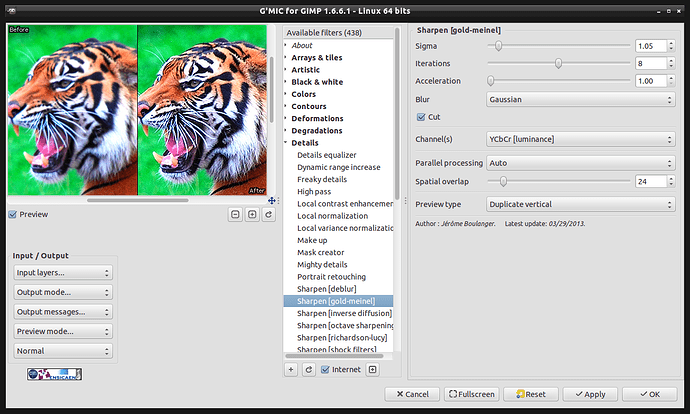Hello there,
I’m happy to announce the final release of version 1.6.6.1 of the G’MIC image processing framework.
Lot of improvements have been made in the G’MIC core, particularly for the math parser. We have now a very capable expression evaluator that will help writing new exciting filters in the future!
(see this link for more details about this particular point).
Here are the changes made since the latest release (1.6.5.2) :
New features:
- [all] Improvements of the math parsers, with new function cut(),gauss(), debug(), pre-defined variables R,G,B,A and ternary operator cond?expr1:expr2. Boundary conditions can also be chosen in offset-specified pixel access i[] and j[].
- [all] New command -div_complex to divide one or several complex pairs of images by another complex pair of images.
- [all] When command selection is [-1], it can be now replaced by a single dot (so -blur[-1] and -blur. are two equivalent commands). Same for [-2] (shortcut …) and [-3] (shorcut …). [-3],[-2] and [-1] are so often uses that they deserve their own shortcuts. This will introduce incompatibilities of the new gmic_stdlib with older versions, so that a new major branch 1.6.6.x of G’MIC has been started.
Improvements:
- [all] Various minor improvements for command -window.
- [all] Math parser has been greatly optimized (more than +50% gain for complex expressions), as well as enriched with new possible “in-place” operators (++,–,+=,*=,…).
- [all] Command -shared now accepts a single argument, as the indice of the image channel to share.
- [gimp] Avoid preview flickering effect when changing filter parameters.
- [gimp] The G’MIC plug-in for GIMP now uses GEGL buffers to read/write image data from/to GIMP. It means the plug-in is now able to retrieve high-bit depth buffers (16bits or 32bits/channels), when compiled for GIMP 2.9.
- [gimp] Parameters labels can be now written using Pango Markup. It will eases the internationalization of filters.
- [gimp] Japanese translation of the plug-in interface is now available.
- [gmicol] Update of the G’MIC Online service, with a new look and new filters.
Bug fixes:
-
[all] Insufficient stack size was allocated for threads on Mac. This is now fixed, making G’MIC finally stable enough on Mac, even with multi-threaded filters. Thanks to Andrea for having figured out what was the issue.

